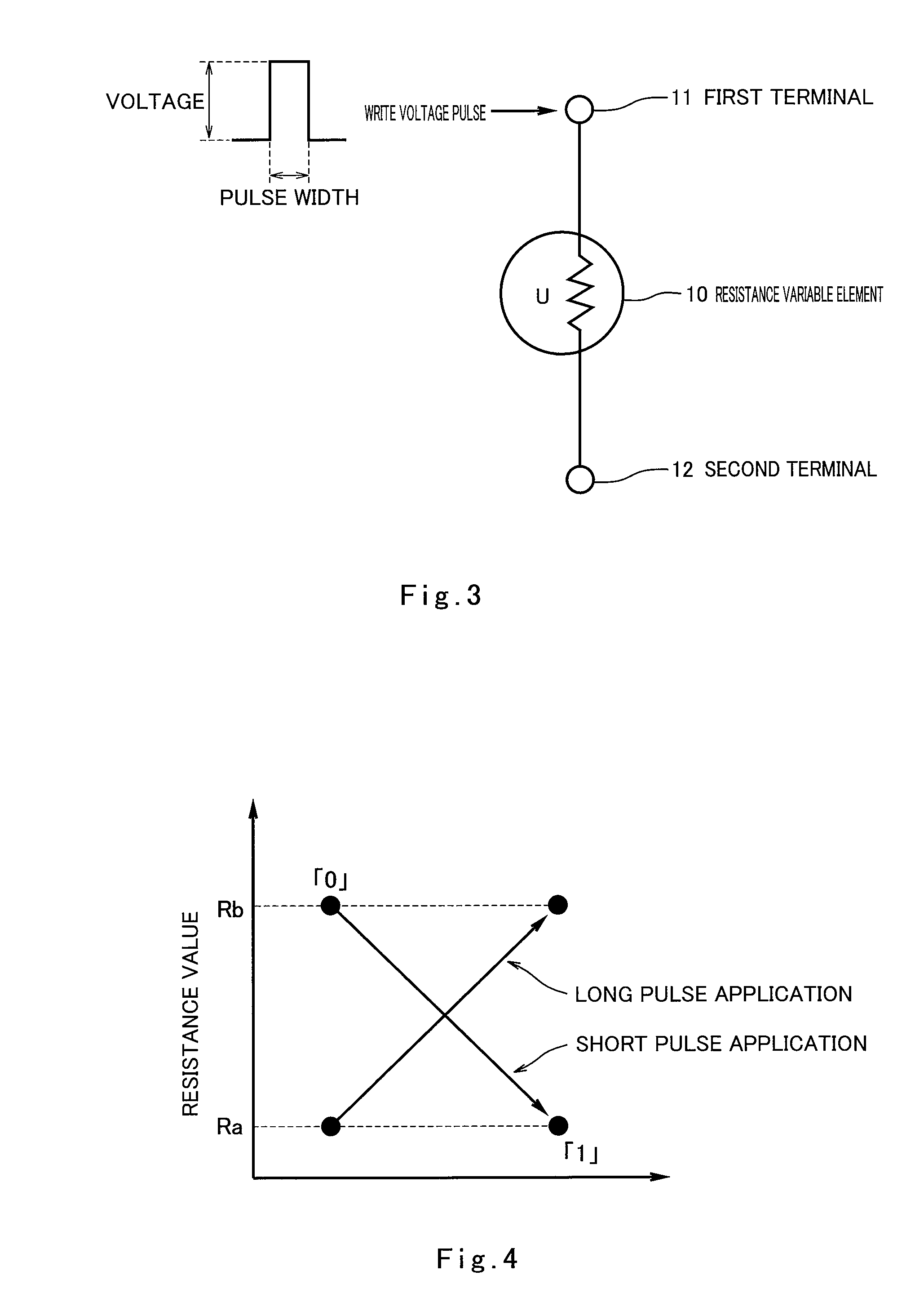Resistance variable element and resistance variable memory apparatus
a resistance variable and memory apparatus technology, applied in digital storage, semiconductor devices, instruments, etc., can solve the problems of complex bidirectional current limiting elements, limited miniaturization of existing flash memory using floating gates, and difficult design of the relation between the resistance value of the resistance variable element and the resistance value of the bidirectional current limiting elemen
- Summary
- Abstract
- Description
- Claims
- Application Information
AI Technical Summary
Benefits of technology
Problems solved by technology
Method used
Image
Examples
embodiment 1
[0084]Configuration
[0085]FIG. 1 is a schematic diagram showing one example of the configuration of a resistance variable element of Embodiment 1 of the present invention.
[0086]As shown in FIG. 1, a resistance variable element 10 of the present embodiment includes a substrate 1, a lower electrode 2 (first electrode) formed on the substrate 1, a resistance variable layer 3 formed on the lower electrode 2, and an upper electrode 4 (second electrode) formed on the resistance variable layer 3. The lower electrode 2 and the upper electrode 4 are electrically connected to the resistance variable layer 3. Note that the upper electrode 4 may be the first electrode, and the lower electrode 2 may be the second electrode.
[0087]The substrate 1 is constituted by a silicon substrate for example.
[0088]Each of the lower electrode 2 and the upper electrode 4 can be constituted by, for example, using one or a plurality of materials selected from the group consisting of Ag (silver), Au (gold), Pt (plat...
example 1
[0123]A lower electrode (20 μm×20 μm) made of Pt was formed on a silicon substrate by sputtering so as to have a thickness of 0.2 μm. A target of ZnFe2O4 and a target of Fe3O4 were prepared, and those targets were caused to electrically discharge at the same time by sputtering. Using masking and lithography, a resistance variable layer (10 μm ×10 μm, 100 μm2) having the spinel structure represented by the chemical formula of (ZnxFe1-x)Fe2O4 was formed on the lower electrode. The temperature of the substrate when forming the resistance variable layer was 300° C. The size of a contact portion where the lower electrode and the resistance variable layer contact each other was 2 μm×2 μm (4 μm2). The thickness of the resistance variable layer was 100 nm. Further, an upper electrode (2 μm×2 μm) made of Pt was formed on the resistance variable layer by sputtering using masking and lithography so as to have a thickness of 0.2 μm. Thus, the resistance variable element was obtained. A contact ...
example 2
[0130]In Example 2, the resistance variable element was formed by the same method as Example 1 except that a parameter was different. Using this resistance variable element, the writing and the reading were carried out.
[0131]To be specific, in Example 2, the voltage applied to each target was adjusted such that the value of X of (ZnxFe1-x)Fe2O4 constituting the resistance variable layer became 0.75. The value of X was verified by the combination of RBS (Rutherford backscattering) and fluorescent X-ray analysis. As a result of this verification, the value of X was 0.75.
[0132]It was confirmed that the resistance variable element of Example 2 was nonvolatile, i.e., the resistance value of the resistance variable element of Example 2 did not change even if the power supply was turned off.
[0133]FIG. 8 is a diagram showing changes in resistance value when the voltage pulses are applied to the resistance variable element of Example 2. As shown in FIG. 8, the resistance state changed from t...
PUM
 Login to View More
Login to View More Abstract
Description
Claims
Application Information
 Login to View More
Login to View More - R&D
- Intellectual Property
- Life Sciences
- Materials
- Tech Scout
- Unparalleled Data Quality
- Higher Quality Content
- 60% Fewer Hallucinations
Browse by: Latest US Patents, China's latest patents, Technical Efficacy Thesaurus, Application Domain, Technology Topic, Popular Technical Reports.
© 2025 PatSnap. All rights reserved.Legal|Privacy policy|Modern Slavery Act Transparency Statement|Sitemap|About US| Contact US: help@patsnap.com



